Comparing Portable Photo Printer Technologies: Polaroid, ZINK, and Dye-Sublimation
With the advent of portable photo printers, we can now instantly transform fleeting beauty into tangible photographs anytime, anywhere. Behind this magical tool are three different printing technologies: Polaroid instant printing, ZINK zero ink printing, and dye-sublimation printing. In the following discussion, we will explore these technologies together, understanding their unique working principles, advantages, and the convenience and endless creative possibilities they offer.
Different Printing Principles: Polaroid, ZINK, and Dye-sublimation
Portable photo printers utilize various printing technologies, including instant printing, Zink printing, and dye-sub printing.
Polaroid Instant (Silver Halide) Printing:
Instant cameras use silver halide printing technology. According to the Encyclopedia Britannica, the photo paper consists of a photosensitive base coated with silver salts and chemicals. When an image is captured, light enters the camera through the shutter, exposing the sensitized layer of the photo paper. The exposed silver salt crystals react chemically and diffuse into the positive layer. After a certain development time, the negative and positive layers are separated, revealing the developed image. The negative layer can be discarded, leaving a finished photograph.
ZINK (Zero Ink) Photo Printing:
ZINK printers use zero ink printing technology, and the special thermal paper used contains color dye crystals that are activated by heat to generate an image. For more detailed information on ZINK printing technology, you can read this article titled "What Is a Zink Photo Printer?" .
Dye-Sublimation Photo Printing:
Dye-sublimation printing technology transfers solid-state pigments from a ribbon onto the printing medium (photo paper) using heat. This technology achieves high-quality color printing.
In the process of dye-sublimation printing, solid-state pigment particles transform directly into gas without going through a liquid state, allowing them to penetrate the surface of the printing medium and bond with its fibers or coating. Through heating, the solid-state pigment particles directly change into gas and permeate the printing medium under pressure, resulting in vibrant and long-lasting colors.
Next, we will compare these three printing technologies from various aspects to examine the advantages and limitations of each technology.
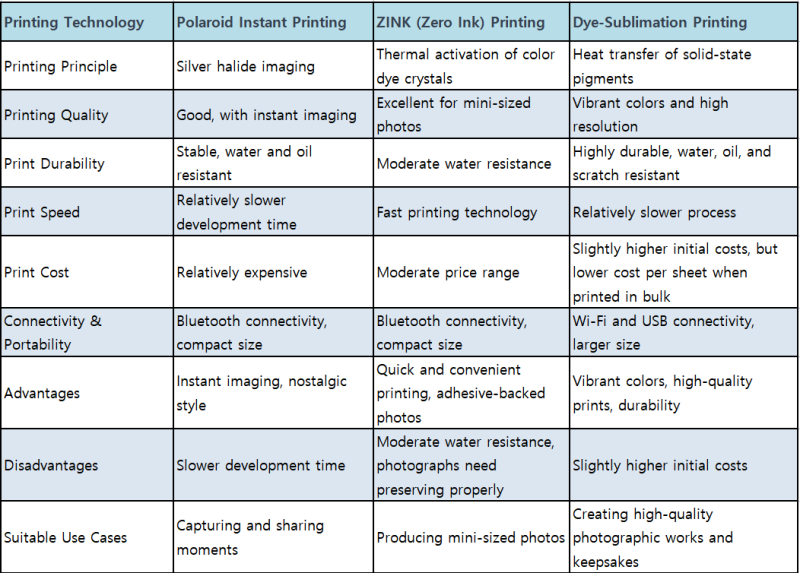
The advantages and disadvant ges of the three printing technologies
a) Printing Quality
Polaroid instant printing utilizes silver halide imaging technology, offering relatively good image quality. Although colors may sometimes lack vibrancy, the advantage of Polaroid photos lies in their instant imaging characteristic, making them ideal for capturing and sharing moments. Those who appreciate wide borders and vintage-style photos will find Polaroid a good choice.
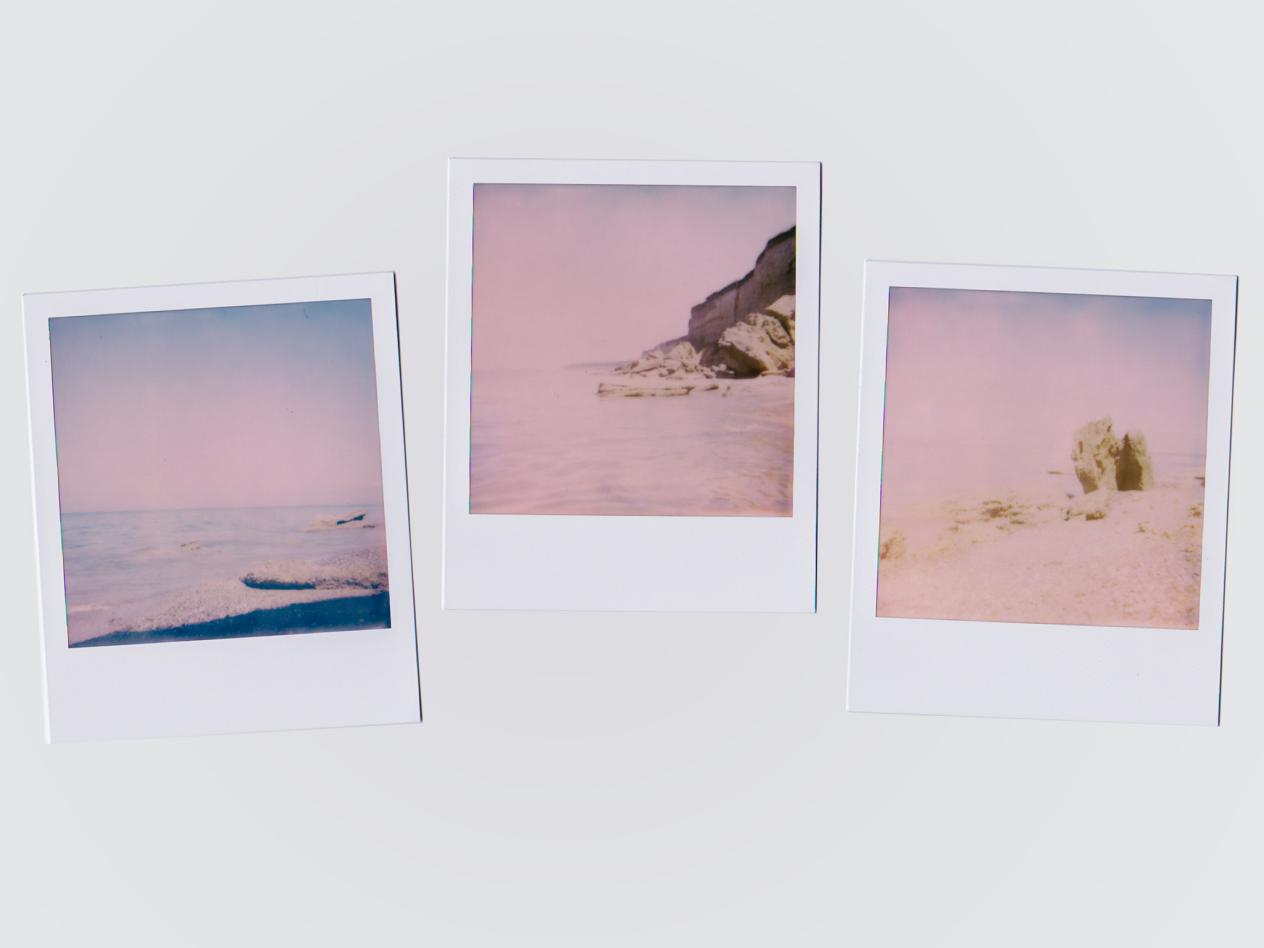
ZINK (Zero Ink) printing technology produces excellent results and is particularly suitable for creating mini-sized photos. Similar to instant printing, these printers are often used for producing quick and portable photos. Additionally, since ZINK photo paper typically has an adhesive backing, the printed photos are well-suited for creating albums, personal notes, and various DIY projects. They are also widely used in toy cameras and portable photo printers.
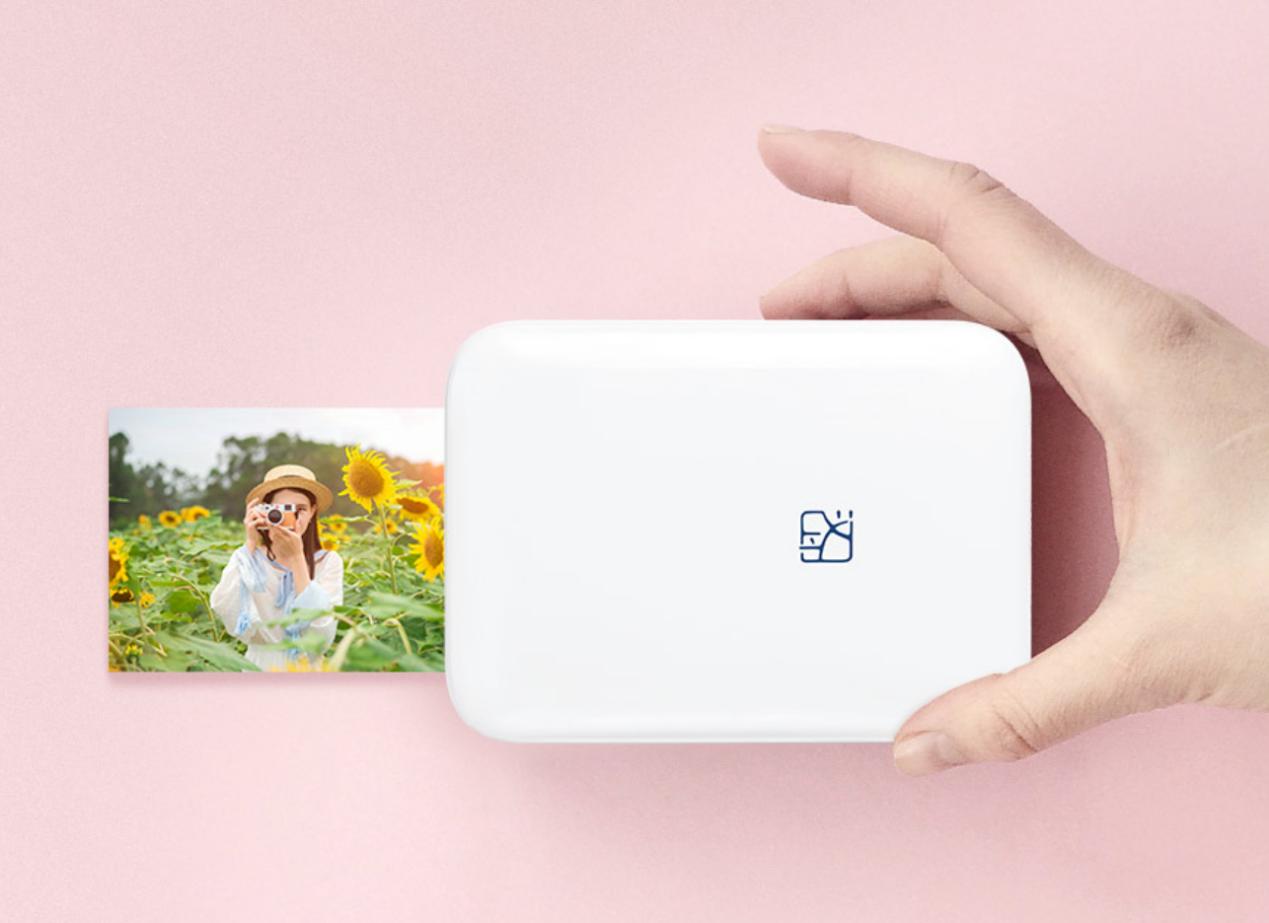
Dye sublimation printing produces photos with vibrant and realistic colors, high resolution, and fine detail rendition. For example, although the HPRT MT53 ZINK pocket-sized printer and HPRT CP4000L dye sublimation photo printer both have a resolution of 300 DPI, the 300 DPI output from dye sublimation is comparable to the exceptional visual performance of inkjet printing at 4800 DPI. This extraordinary visual expression makes dye sublimation printing an excellent choice for creating high-quality photographic works, precious mementos, and gorgeous photo albums.

b) Print Durability
Polaroid photos are formed through chemical reactions, resulting in higher stability and some water and oil resistance.
ZINK photos have moderate water resistance, but prolonged exposure can cause discoloration. For example, when exposed to high temperatures inside a car during the summer, the image may turn red.
Photos printed with dye sublimation undergo a lamination process, providing them with water, oil, and scratch resistance, making them highly durable.
The HPRT CP4000L is a portable photo printer with a resolution of 300 dpi. It utilizes the latest dye sublimation printing technology, delivering vibrant, bright, and highly detailed photos. This compact photo printer offers Wi-Fi connectivity, allowing users to conveniently print from their iPhone or iPad. Additionally, it incorporates advanced automatic photo lamination technology, ensuring that your photos are waterproof, dustproof, and resistant to oxidation, thus safeguarding your precious memories.
c) Print Speed
Instant Polaroid pictures have a relatively fast printing speed, but they require a certain amount of time (generally over 30 seconds) for development, resulting in an overall slower printing speed compared to ZINK Zero Ink printing.
The most significant feature of ZINK printing is its speed. This fast printing technology is highly popular for travel, parties, gatherings, and other activities, allowing for quick production of commemorative photos with a certain level of quality.
The HPRT MT53 mini photo printer uses ZINK (Zero Ink) technology, intelligent high-definition imaging, and comes with the self-developed "HeyPhoto" photo editing app, allowing you to enjoy the creative printing fun while staying a step ahead. The accompanying adhesive-backed photo paper is highly sticky and serves as a magical tool for DIY enthusiasts, allowing you to stick them on phone cases, suitcases, journals, and more.
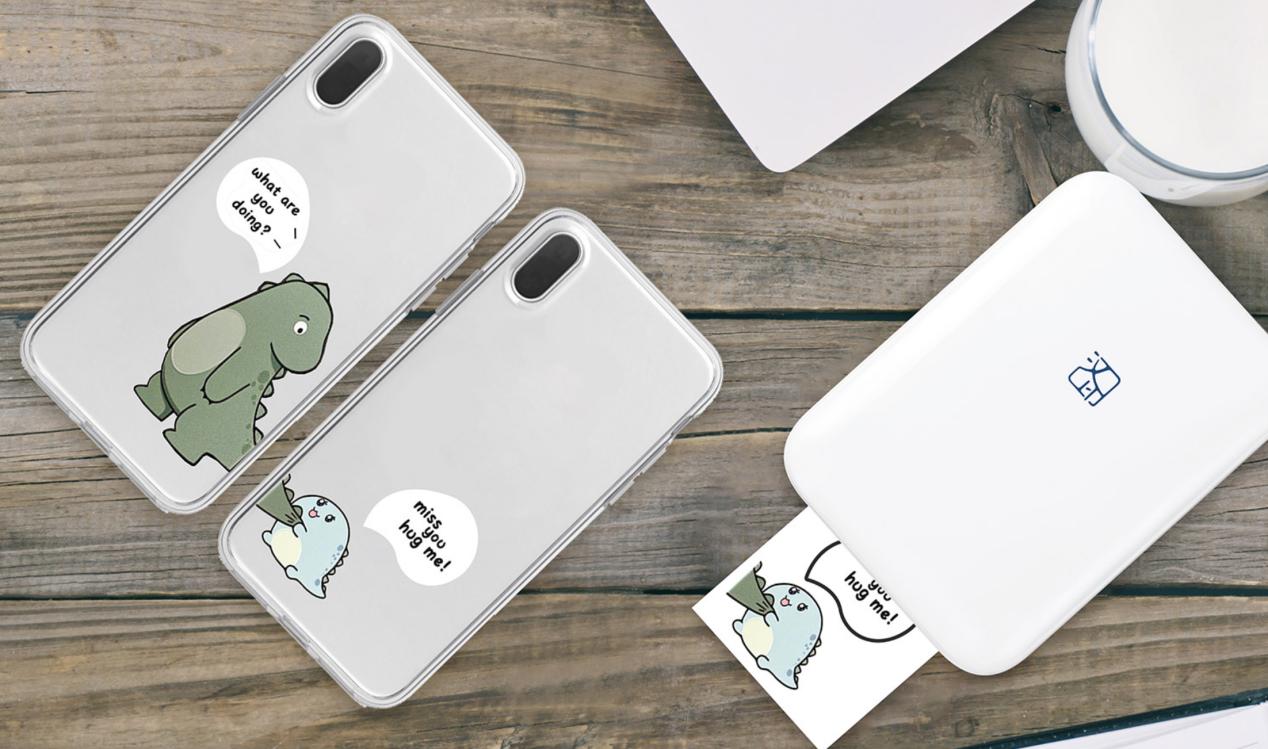
Dye sublimation printing has a relatively slower speed as it requires the sequential sublimation process of three colors: yellow, magenta, and cyan, followed by lamination.
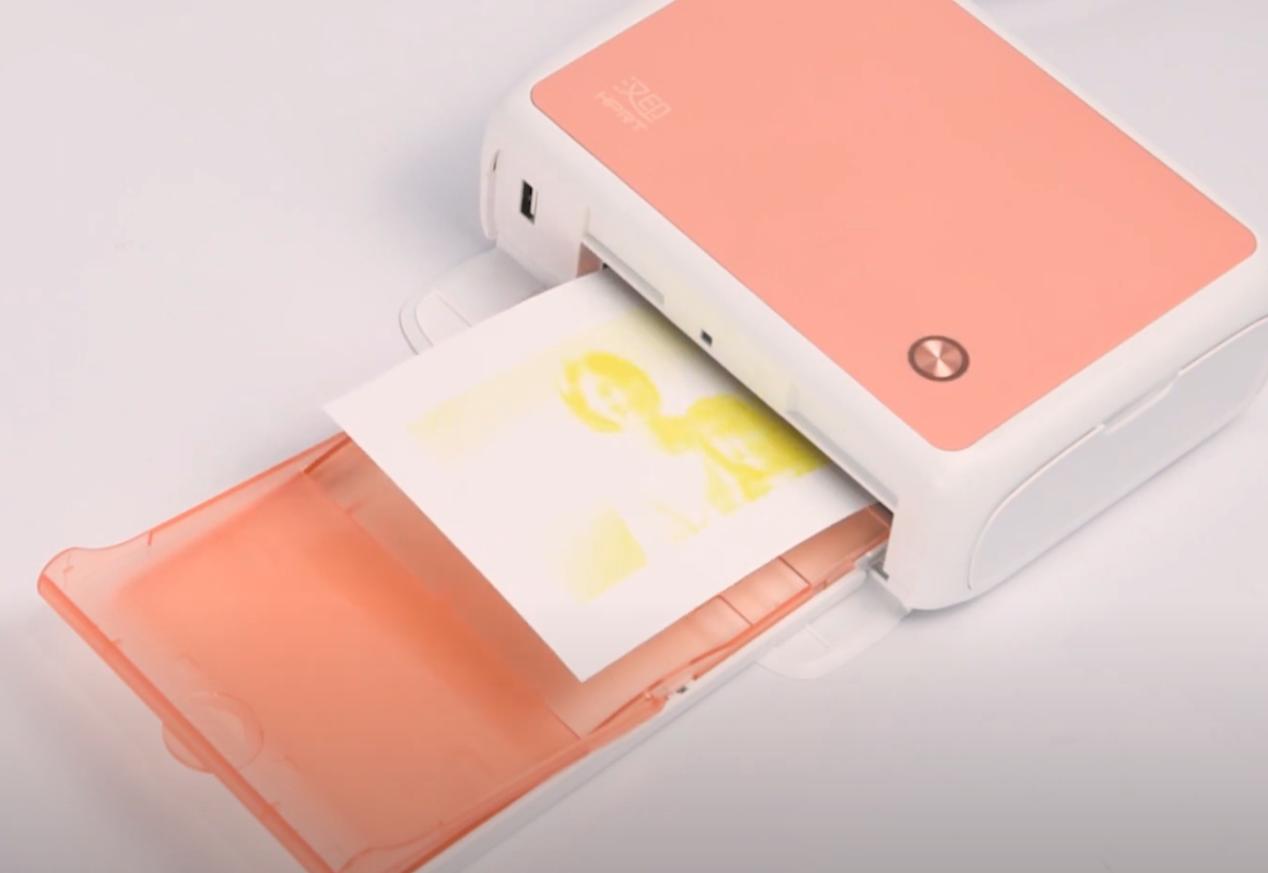
d) Print Cost
Printing with Polaroid instant film tends to be relatively expensive, with the cost of a single photo exceeding $0.75.
The average cost of ZINK photo paper is around $0.25 per sheet, offering a moderate price range.
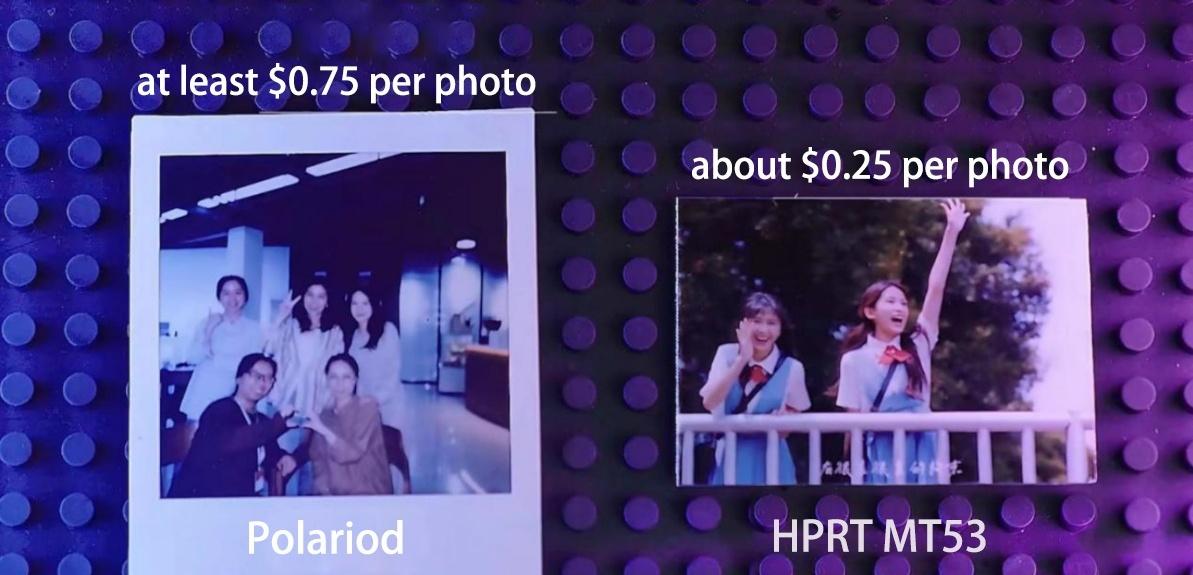
The initial consumable costs of dye sublimation printing may be slightly higher, including ribbon and photo paper. However, when purchased and printed in bulk, the cost per sheet generally falls below $0.3. Considering the excellent photo quality provided by dye sublimation printing, it offers a favorable cost-performance ratio.
e) Connectivity and Portability
Generally, Polaroid photo printers support Bluetooth connectivity and can be compact in size, achieving excellent portability.
ZINK printers also support Bluetooth connectivity, with compact product designs that are easy to carry, comparable to Polaroid photo printers.
Dye sublimation printers have a larger size and generally support Wi-Fi and USB data connections, allowing for connectivity with various devices.
Currently, there are also smaller and portable dye-sublimation photo printers available in the market, like the HPRT CP2100. This smartphone photo printer supports Bluetooth connectivity, providing both portability and high-quality photo output. However, due to their compact size and unique consumable cartridge structure, the cost per sheet of these photo printers may slightly increase.
In summary, different printing technologies are suitable for different needs and purposes. Polaroid instant printing provides instant imaging and a nostalgic style, ideal for capturing and sharing moments. ZINK printing offers quick and convenient printing, suitable for producing mini-sized photos, such as with the HPRT MT53. Dye sublimation printing provides vibrant, lifelike colors and durability, making it suitable for creating high-quality photographic works and keepsakes, exemplified by the HPRT CP4000L.
Whether you prioritize printing quality, durability, printing speed, cost, or connectivity and portability, you can choose the appropriate photo printing technology and corresponding printer based on your personal needs, thereby presenting your creativity and precious moments in the best possible way.








